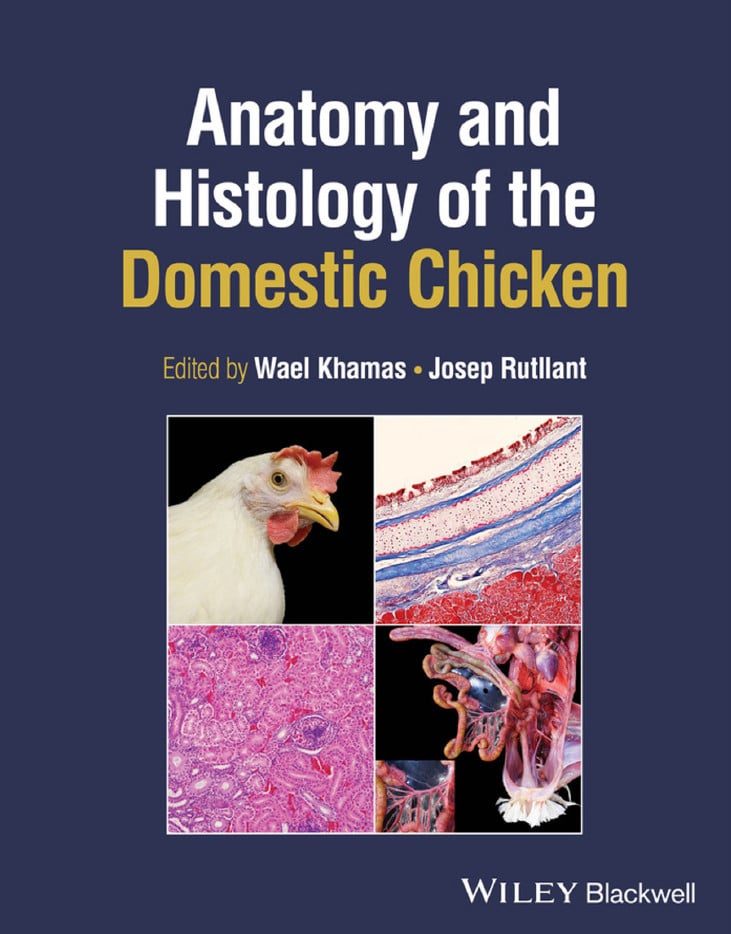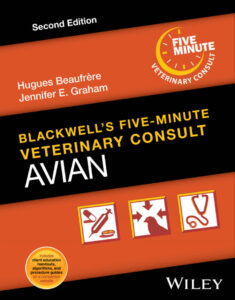
By Josep Rutllant and Wael Khamas
Anatomy and Histology of the Domestic Chicken is a state-of-the-art atlas of avian anatomy that provides a complete collection of both original gross anatomy and histology photographs and texts of all body systems of the birds based on the domestic chicken to depict anatomic features. Using cutting-edge technology to create visualizations of anatomic structures, this exhaustive reference includes both gross anatomical structures/organs and their histological details next to each other. This approach enables readers to understand the macro- and micro-pictures of each organ/structure under study.

Recommended Book:
Features
Book Features:
- External features of the body, including regions, features, ornaments, shape, feathers, skin, and the uropygial gland
- Musculoskeletal characteristics including cartilage and bone formation and classification, as well as flight and ambulatory muscles
- Digestive system, including the beak, esophagus, crop, proventriculus, ventriculus, intestines, and accessory glands
- Respiratory system, including external nares, nasal cavity, trachea, upper larynx, syrinx, lungs, and air sacs
- Urinary system, including kidneys and the ureter, cloaca-urodeum, and genital system, covering differences between males and females
- Endocrine system, including pituitary, pineal, adrenal, pancreas, thyroid, and parathyroid glands
- Nervous system with central and peripheral divisions and sense organs including eye and ear
- Lymphatic system, with descriptions of the primary and secondary lymphatic organs
- Egg anatomy and development of the chick embryo
- Applied anatomical concepts important for clinical maneuvers and necropsy
Table of Contents
- External Features of Chicken
- Skin (Epidermis, Dermis, Hypodermis)
- Structures associated with the Skin (Patagium, Operculum, Ornaments)
- Feathers (Development, Description, Types, Parts, Molting)
- Lamellar Corpuscles
- Debeaking
- Eyelids, Vent, Uropygial Gland
- Brood Pad, Bursa Sterni
- Legs (Podotheca, Scutes, Digits, Claws, Spur, Pads)
- Thermoregulation
- Skeletal System
- Introduction to Skeletal System
- Cartilage and Bone Embryonic Origin
- Cartilage Cell Types (Chondroprogenitor, Chondroblast, Chondrocyte, Chondroclast)
- Types of Cartilages (Hyaline, Fibrocartilage, Elastic)
- Cartilage Development
- Calcium Homeostasis
- Bone Cell Types (Mesenchymal, Pericyte, Osteogenic, Osteoblast, Osteocyte, Osteoclast)
- Ossification (Intramembranous, Endochondral)
- Axial Skeleton (Skull, Vertebrae, Notarium, Ribs, Sternum)
- Sesamoid and Pneumatic Bones
- Pectoral and Pelvic Girdle
- Pectoral Limb (Wing)
- Pelvic Limb
- Arthrosis (Joints)
- Muscular System
- Introduction to Muscular System
- Muscle Histology (Smooth, Cardiac, Skeletal)
- Muscle Nomenclature
- Types of Skeletal Muscle Fibers
- Muscle Cells (Myocyte, Satellite)
- Skeletal Muscle Blood Supply and Innervation
- Muscle Spindle
- Tendon Histology and Modifications
- General Description of Skeletal Muscle
- Cutaneous Muscles
- Flight Muscles (Pectoral, Wing Muscles)
- Muscles of the Pelvic Region (Thigh, Leg)
- Abdominal Muscles
- Digestive System
- Introduction to Digestive System
- Oral Cavity and Pharynx (Beak, Tongue, Salivary Glands, Taste Buds, Pharyngoesophageal Junction)
- Hyoid Apparatus
- Esophagus
- Stomach (Proventriculus, Intermediate Zone, Gizzard)
- Small Intestine (Duodenum, Jejunum, Ileum)
- Large Intestine (Rectum, Ceca)
- Cloaca, Vent
- Liver (Hepatic Portal System and Blood Supply)
- Pancreas
- Respiratory System
- Introduction to Respiratory System
- Nostrils and Nasal Cavity
- Larynx
- Trachea
- Syrinx
- Lungs
- Direction of Airflow
- Blood-Gas Barrier
- Air Sacs
- Urinary System
- Introduction to Urinary System (Composition, Function, Development)
- Kidney (Anatomy, Histology)
- Ureter, Urodeum
- Blood Supply, Innervation
- Urine
- Reproductive System
- Male Reproductive System (Testes, Epididymis, Deferent Duct, Phallus, Spermatogenesis, Spermatozoa)
- Female Reproductive System (Ovary, Oviduct, Cloaca)
- Formation of Chicken’s Egg (Yolk, Albumen, Shell Membranes, Testa)
- Endocrine System
- Introduction to Endocrine System
- Physiological Balance (Homeostasis)
- Major Endocrine Glands (Hypothalamus, Pituitary, Adrenal, Thyroid, Parathyroid, Ultimobranchial Bodies, Carotid Body, Pineal Gland, Islets of Langerhans, Gonads, Digestive Enterochromaffin Cells)
- Sense Organs
- The Eye (Eyeball, Lens, Eye Chambers, Vision)
- The Ear (External, Middle, Inner, Hearing)
- Cardiovascular System
- Introduction to Cardiovascular System
- Heart (Topography, Pericardial Sac, Surface Anatomy, Chambers, Valves, Conducting System, Arterial Supply, Venous Drainage)
- General Arterial System (Pulmonary Trunk, Systemic Arteries)
- Venous System (Pulmonary Veins, Systemic Veins)
- Blood Collection Sites
- Hepatic Portal System
- Renal Portal System
- Carotid Body/Sinus
- Lymphatic System
- Introduction to Lymphatic System
- Cells of the Lymphatic System (Lymphocytes, Monocytes, Macrophages, Reticular Cells)
- Primary and Secondary Lymphatic Organs (Bursa of Fabricius, Thymus, Spleen, Cecal Tonsils, Gut-Associated Lymphoid Tissue)
- Maternal Transfer of Immunity
- Lymphatic Vessels
- Nervous System
- Introduction to Nervous System
- Neurons (Types, Synapse)
- Ganglion (Sensory, Autonomic)
- Glial Cells (Microglial, Macroglial)
- Peripheral Nervous System Cells (Schwann, Satellite)
- Meninges
- Brain Ventricles
- Cerebrospinal Fluid (CSF)
- Blood Brain Barrier
- Cerebrum (Telencephalon, Diencephalon, Mesencephalon, Metencephalon, Myelencephalon)
- Reticular Formation
- Spinal Cord
- Autonomic Nervous System (Sympathetic, Parasympathetic)
- Applied Chicken Anatomy
- Examining from a Distance (Behavioral Deviations, Abnormal Mentation, Posture)
- Physical Examination (Feathers, Head, Wattles, Eyes, Ears, Thorax, Cloaca, Legs)
- Specialized Clinical Procedures (Identification Placement, Culture Techniques, Blood Collection)
- Chicken Necropsy
- Introduction to Necropsy
- Euthanasia and Carcass Disposal
- Chicken Disposal
- Facilities and Materials Needed (Personal Protective Equipment, Histopathological Examination, Collection of Microbiological Samples, Molecular Diagnosis, Toxicological Investigation)
- Whole Carcass Conservation
- Necropsy Protocol (External and Internal Examination)
- The Egg Anatomy
- Introduction to Egg Anatomy
- The Germinal Disc
- The Yolk
- The Albumen
- The Eggshell (Shell Membranes, Testa, Cuticle)
- Fertilization and Chick Embryo Development
- Introduction to Fertilization and Development
- Avian Fertilization (Sperm Deposition, Storage, Transport, Ovulation, Fertilization)
- Chick Embryo Development
- Index
Get This Book
You May Also Like:















![Ettinger’s Textbook of Veterinary Internal Medicine 9th Edition [PDF+Videos] Ettinger’s Textbook of Veterinary Internal Medicine 9th Edition [True PDF+Videos]](https://www.vet-ebooks.com/wp-content/uploads/2024/10/ettingers-textbook-of-veterinary-internal-medicine-9th-edition-100x70.jpg)





